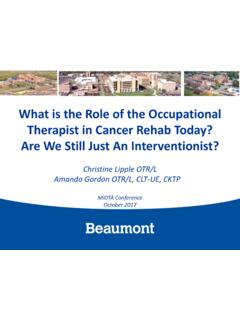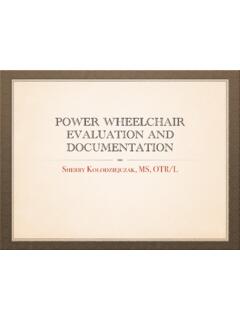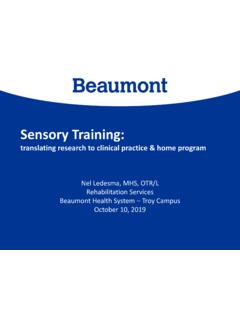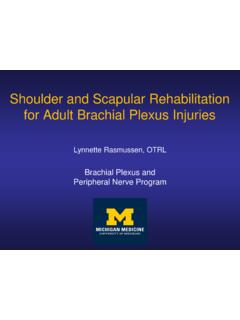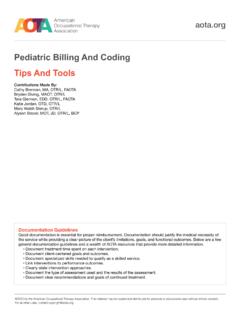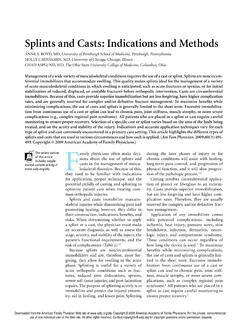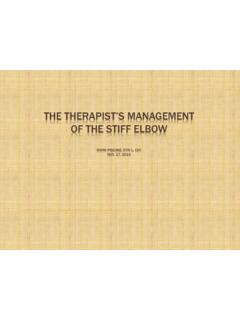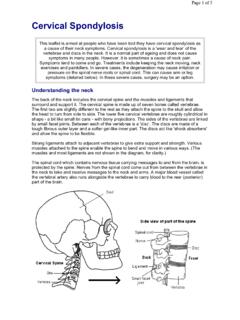Transcription of TREATING HAND STIFFNESS - MiOTA
1 TREATING HAND. STIFFNESS . NANCY HOCK, OTRL, CHT. MiOTA 2017. WHY DOES STIFFNESS OCCUR? Prolonged Immobilization Traumatic Injury/Multiple Injury Presence of Sympathetic Involvement Patient Characteristics Delay in Appropriate Treatment Insurance Limitations PROLONGED IMMOBILIZATION. Non-surgical treatment Cast Length Increased healing time TRAUMATIC INJURY/MULTIPLE INJURY. SYMPATHETIC INVOLVEMENT. PATIENT CHARACTERISTICS. Non-compliance Poor Tolerance Roles/Occupation Fear Motivation (secondary gain). Pain DELAY IN APPROPRIATE. TREATMENT. WH Y ? ? ? ? INSURANCE ENVIRONMENT. Limited visit authorization High co-pays Many services not authorized Splint/DME coverage HOW TO AVOID STIFFNESS .
2 Control edema What moves fluid? AROM/PROM as soon as possible The just right challenge (no pain/no gain?? NO!). EVALUATING STIFFNESS . WH A T I S T H E S O U R C E ? IS IT A JOINT PROBLEM? Compare AROM to PROM. If good passive and poor active NO. If AROM and PROM are similar Could be! MOST DIFFICULT TO TREAT. Wrist extension MCP flexion IP extension JOINT STIFFNESS . (SOFT TISSUE/JOINT). Ligament shortening Joint capsule tightness Bony block Evaluate end feel of joint Soft springy (could be edema). Hard abrupt end point IS IT A STRENGTH PROBLEM? INTRINSIC/INTEROSSEOUS TIGHTNESS.
3 Decreased PIP passive flexion with MP passive extension Lumbrical tightness? Interosseous tightness? EXTRINSIC TIGHTNESS. Significant difference between distal passive motion which is impacted by proximal passive joint motion. The position of the wrist impacts the performance of the digits ORL TIGHTNESS. (LANDSMEER'S LIGAMENT). Decreased passive DIP flexion with PIP passive extension. SCAR. Watch blanching/whiteness with ROM. Scar adhesion may limit tendon glide Where it is white, it is tight! LIMITED TENDON GLIDE. Evaluate passive versus active ROM. If good passive and bad active Yes If AROM and PROM are similar Could be!
4 NERVE FUNCTION ASSESSMENT. Decreased nerve function may have resulted in joint contracture. May not be evident until joint contracture is improved. OBSERVE PATTERNS OF MOVEMENT. Does the MP extend before the wrist? Reverse pattern of fisting? OTHER UNIDENTIFIED INJURIES. Unidentified wrist injury may prevent improvements in digit motion. CHANGE IN CORTICAL. REPRESENTATION. Motor areas that are not used lose cortical representation Judith Colditz, ASHT Times, Volume 21, Issue 3. WHAT DO YOU SEE? TREATMENT OPTIONS. NOW WHAT DO I DO?? MANAGE EDEMA. Increase tissue pressure (coban, isotoner glove, tubi-grip).
5 Elevation Manual lymph drainage AROM. COBAN WRAP. ENCOURAGE APPROPRIATE PATTERNS. OF MOVEMENT. Wrist position in slight extension to encourage fist (encourage tenodesis). Lead with hook fist prior to MP. flexion (avoid interosseous fisting). ADDRESS TIGHTNESS. Intrinsic Extend MP and flex IP. Extrinsic Flex wrist and digits Extend wrist and digits IDENTIFY OPTIMAL POSITION TO. OBTAIN TENDON GLIDE. Joint motion distal to the adherence Proximal glide of extensors to gain digit extension Distal glide of extensors to gain digit flexion Proximal glide of flexors to gain digit flexion Distal glide of flexors to gain digit extension RELATIVE MOTION ORTHOSIS.
6 Block MP flexion to encourage flexion at the IP joints. RELATIVE MOTION ORTHOSIS. Block MP extension to encourage extension at PIP. HOW MUCH MOTION IS NEEDED? Digits MP 61 degrees PIP 60 degrees DIP 39 degrees Thumb MP 21 degrees IP 18 degrees Means, K. R., Saunders, R. J., & Graham, T. J. (2011) Pathophysiology and surgical management of the still hand. In T. M. Skirvin, A. L. Osterman, J. M. Fedorczyk, & P. C. Amadio, (Eds), Rehabilitation of the Hand and Upper Extremity, (6th ed. P. 886). St. Louis, MO: Mosby. PROVIDE APPROPRIATE PROM. Too aggressive = Increased inflammatory response Passive motion of the injured hand should be defined as the gentle encouragement of the tissue to reach a maximum available length (Colditz, 2011).
7 Colditz, J. C. (2011). Therapist's management of the stiff hand.. In T. M. Skirvin, A. L. Osterman, J. M. Fedorczyk, & P. C. Amadio, (Eds), Rehabilitation of the Hand and Upper Extremity, (6th ed. P. 886). St. Louis, MO: Mosby. MANAGE SCAR WHICH IS LIMITING. MOTION. ULTRASOUND - THERMAL. PARAMETERS. Ultrasound: heat tissue .6C/Minute - Need 4C temperature change to increase collagen tissue extensibility Ultrasound in conjunction with a stretch 3mHz = 1-2 cm 1mHz = 3-5 cm ULTRASOUND PARAMETERS. Intensity 1 MHz freq 3 MHz freq C/min ULTRASOUND CONSIDERATIONS. Absorption rates: Blood 3%.
8 Fat 13%. Muscle 24%. Blood vessel 32%. Skin 39%. Tendon/ligament 59%. Cartilage 68%. Bone 96%. IONTOPHORESIS. SCAR MANAGEMENT. Silicone gel sheeting Scar mobilization Elastomer scar mold TISSUE RESPONSE. Dr. Paul Brand - Journal of Hand Therapy 1995. It is better not to use the word stretch for what should be the long-term growth.. Developed the Torque Angle Curve (TAC). Interval goniometric measurements suggesting the more gentle the slope, the more compliant the tissue, the sharper the slope, the more stiffer the tissue. TISSUE RESPONSE. Paul LaStayo & Ken Flowers 1994, JHT.
9 Suggested TERT. The time that a stiff joint is positioned at its available end range impacts the improvement in PROM. TISSUE RESPONSE. Ken Flowers Journal of Hand Therapy 2002. Modified Weeks Test for splinting decision hierarchy First PROM measurement (cold reading). Thermal modality (prefer fluidotherapy for 20 min w/exercise). AROM with overpressure 10 min Second PROM measurement ((preconditioned reading). If gain in 20 degrees, no splint If gain is 15 degrees consider static splint If gain is 10 degrees, dynamic splint If gain is 5 degrees, static progressive splint KEY CONCEPTS KEN FLOWERS.)
10 Elastic recovery of ligamentous length follows stretch Trauma and immobilization result in adaptive shortening/ STIFFNESS Gentle prolonged stress promotes tissue lengthening Dosage of force application is determined with the splinting decision hierarchy Patient response is monitored to assess safety and effectiveness of splint program SPLINTING. Dynamic soft end feel Serial Static can help with edema reduction Static Progressive used with greatest resistance or prolonged STIFFNESS INCREASE JOINT ROM / SOFT. TISSUE LENGTH / TENDON GLIDE. Splinting TERT, low load force for prolonged period of time Static progressive splinting vs dynamic Serial static splinting Casting Motion to Mobilize STIFFNESS Judith Colditz (Hand Lab).
